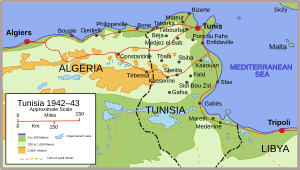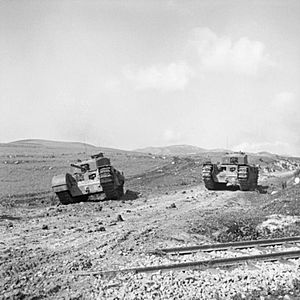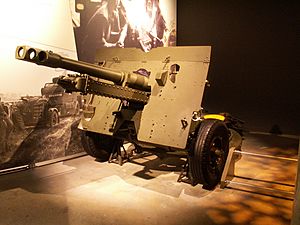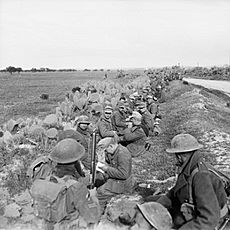Operation Ochsenkopf facts for kids
Quick facts for kids Operation Ox Head/Unternehmen Ochsenkopf |
|||||||
|---|---|---|---|---|---|---|---|
| Part of the Tunisia Campaign of the Second World War | |||||||
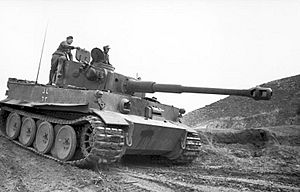 Panzer VI (Tiger I) in Tunisia, 1943 |
|||||||
|
|||||||
| Belligerents | |||||||
| Commanders and leaders | |||||||
| Strength | |||||||
| Casualties and losses | |||||||
| 4,200 casualties (2,300 prisoners) 16 tanks 31 guns 40 vehicles |
4,500 casualties (2,200 prisoners) 71 tanks 60 vehicles |
||||||
Operation Ox Head (also known as Unternehmen Ochsenkopf) was a major attack by the Axis forces in Tunisia. It happened during the Tunisia Campaign of World War II. The battle lasted from February 26 to March 4, 1943. It is also known as the Battle of Sidi Nsir and the Battle of Hunts Gap.
The Axis forces, mainly German and Italian troops, wanted to capture important towns and areas. These included Medjez el Bab, Béja, El Aroussa, Djebel Abiod, and a place called Hunt's Gap. These areas were held by the British First Army. The Axis hoped to push the Allies back and delay their advance. They did gain some ground, but they didn't achieve their main goals. The operation was stopped because the Axis lost too many soldiers and tanks, especially their powerful Tiger tanks. Operation Ox Head was the last big attack by the German 5th Panzer Army before they surrendered in May 1943.
Contents
Background of the Battle
After a battle called Battle of Kasserine Pass in February 1943, the Axis forces created a new command. It was called Army Group Africa. This group was in charge of the German 5th Panzer Army and the Italian 1st Army in Tunisia.
German leader Adolf Hitler wanted General Hans-Jürgen von Arnim to lead this new group. But another German commander, General Albert Kesselring, thought General Erwin Rommel should be in charge. Rommel was then appointed to lead Army Group Africa on February 23.
Rommel was told to stop the attack at Kasserine. This was because the Allies were sending more troops to the area. Instead, he was ordered to attack the British Eighth Army. This British army, led by General Bernard Montgomery, was getting close to the Mareth Line defenses from the east.
On February 24, General Arnim flew to Rome without talking to Rommel. He pushed for an attack towards Béja. Arnim believed the British First Army had sent many troops south. He thought this was to help save Sbiba and Thala. Kesselring agreed to Arnim's plan for a wide attack against the British V Corps on February 26.
Axis Battle Plan
Operation Ox Head was designed to break through British defenses on February 26. The German forces, led by General Friedrich Weber, planned to attack in three main groups. These groups were like the horns of a bull's head.
- The northern group, with most of the tanks, would advance from Mateur. Their goal was to capture Béja, about 25 mi (40 km) west of Medjez.
- The second group would attack from Goubellat. They aimed to surround the British at Mejez El Bab.
- The third group would attack in the Bou Arouda valley. They would then move through El Aroussa to Gafour. Their main target was the road junction at El Aroussa.
In the north, another German force would carry out a smaller operation. This was called Operation Disembarkation (Unternehmen Ausladung). Its goal was to defeat the British in the Sedjenane valley. It would also cut off communication lines and protect the main attack's northern side. These attacks were meant to force the Allies to retreat. This would give Rommel time to prepare another attack against the British Eighth Army.
Operation Disembarkation

Operation Disembarkation began on the morning of February 26. Its goal was to go around the British in Sedjenane. German and Italian elite troops, including paratroopers, led the attack. They had air support from the German air force (Luftwaffe).
The Axis forces made good progress across the hills. These hills were held by French troops who were not well-equipped. The French fought back but were eventually defeated, and many were captured. On February 27, British troops and commandos moved in to stop the German advance. However, they lacked air support and didn't have enough artillery ammunition.
Until March 1, the British launched costly but successful counter-attacks. These slowed down the Axis advance. On March 2, a British counter-attack failed, and the battalion had to pull back. More German attacks on Sedjenane that day and the next were stopped. A strong counter-attack by British troops and Churchill tanks pushed the Germans back.
However, the British position became difficult. French troops further west in the Medjez area had pulled back. Axis troops then took over high ground overlooking the town. This made the British position vulnerable. On March 4, the British retreated about 15 mi (24 km) from Sedjenane. They moved towards Djebel Abiod to make their front line stable again. The German attack on Djebel Abiod was delayed for five days because of the strong defense at Sedjenane.
The Battle Unfolds
Southern Attack Group
The southern part of the operation was carried out by a German battle group. This group included the Hermann Göring Parachute Division and the 334th Infantry Division. They also had supporting tank battalions. Protecting this area was a British force called Y Division. This was a mixed group of commandos, Guards regiments, paratroopers, and Churchill tanks.
The German battle group attacked on the evening of February 25. Their first targets were Tally Ho corner, an important road junction, and a small hill called Fort MacGregor. The German air force attacked British positions. At Fort MacGregor, German paratroopers attacked British soldiers. After two German attacks were pushed back, the paratroopers broke through. The British defenders were quickly overwhelmed. Another hill, Djebel Djaffa, was also attacked by paratroopers. The French troops there were surprised and captured.
A quick British counter-attack on Fort MacGregor was attempted but failed. The British then heavily bombarded the hill with artillery for hours. When they attacked again, the hill was empty except for a few shell-shocked Germans. The paratroopers had suffered heavy losses and had to retreat. The British recaptured Djebel Djaffa the next day after some fighting.
The 334th Division attacked Tally Ho corner just before midnight. They surprised and overran the British commando defenders. The Germans then pushed on to a small ridge. Here, two battalions of the Hermann Göring Division and a tank company attacked British Churchill tanks. The Churchill tanks, firing from hidden positions, destroyed four German Panzer IV tanks. They also disabled three Panzer III tanks and destroyed a powerful 88 mm gun. The German infantry suffered many casualties and pulled back. The British received more troops and counter-attacked, pushing the Germans back into the hills.
After dark, the British advanced towards Steamroller Farm. This farm was held by about 2,000 German soldiers. On February 28, British Churchill tanks and Coldstream Guards moved towards the farm. German artillery and dive bombers attacked them, and the British lost five Churchill tanks. One Churchill tank, led by Second Lieutenant J. C. Renton, bravely charged forward. It flattened an 88 mm gun and then reached the top of the pass, surprising the Germans.
The tanks destroyed German transport vehicles and two Panzer III tanks. The Germans fled as darkness fell. This tank attack destroyed many German anti-tank guns and vehicles. It also caused nearly 200 casualties. The next day, the British occupied the farm. The German commander thought he had been attacked by a "mad tank battalion" and ordered a full retreat.
Northern Attack Group
The northern attack group had 77 tanks, including twenty powerful Tiger tanks. On February 26, the Germans quickly captured the small village of Sidi Nsir and its railway station. This area was important because roads and railways connected Béja and Mateur there.
The British 172nd Field Regiment, with its 25-pounder gun-howitzers, and the 5th Battalion Hampshire Regiment defended a farm nearby. Their job was to slow down the German attack on Béja. This would give defenders at Hunt's Gap time to prepare. The Germans were estimated to have attacked with about 13,000 infantry soldiers.
On the morning of February 27, German mortars began firing on the British guns. German tanks then drove down the road. British 25-pounder guns opened fire, hitting leading German tanks. These tanks hit mines and pulled back with their infantry. Later, the Germans tried another attack, but British artillery fire broke it up.
By 1:00 p.m., thirty German tanks and infantry were very close. German fighter planes attacked each British gun, causing casualties. Just after 2:30 p.m., German infantry moved around the southern side. At 3:00 p.m., German infantry began firing at close range. A column of tanks, led by a Tiger, moved into the battery position. The British gunners switched to armor-piercing shells and knocked out three tanks, blocking the road.
At 5:30 p.m., another German attack began. Seven tanks were hit, but one by one, the remaining British guns were destroyed. By nightfall, only one 25-pounder gun and a few machine guns remained. The last radio message was "Tanks are on us." Only nine British soldiers from the original group made it back to British lines. The defense of Sidi Nsir bought valuable time. This allowed the British to prepare defenses at Hunt's Gap, a narrow pass about 15 mi (24 km) north-east of Béja.
At Hunt's Gap, the British had many 25-pounder guns, medium guns, and Churchill tanks. They had prepared a "tank-killing zone" with minefields and anti-tank guns. British fighter-bombers, equipped with powerful 40 mm guns, circled overhead, ready to attack German tanks.
On February 28, Rommel ordered the German commander, Rudolf Lang, to hurry. Lang ordered a pre-dawn attack by about ten Panzer IVs and infantry. British Churchill tanks quickly knocked out four Panzer IVs, stopping the attack. The Germans attacked again and broke through some British lines. But the British tanks stopped them until dusk.
The next day, Lang found he was only 10 mi (16 km) from Hunt's Gap. However, he had only six working tanks left. A thick fog fell, making it hard for British planes to fly. The Germans attacked again in the fog, surprising some British troops. But the rest of the attack was pushed back by artillery fire. When the fog lifted, British planes immediately attacked German supply columns. German tanks and infantry suffered many casualties. The road they were using became full of bomb craters and burning vehicles, forcing a retreat.
The British held their positions. They surprised the Germans with a counter-attack, killing forty Germans and capturing sixty. Further along the road, artillery broke up another German attack. Eight Tiger tanks were stuck in mines and had to be blown up by their crews to prevent capture.
On March 2, the Germans retreated. They had lost over forty tanks and nearly sixty other armored vehicles. Two out of four German infantry battalions were captured. Many of the prisoners had fought on the Eastern Front and said they had never experienced such heavy bombing. The attack had failed to achieve its main goals, so the German commander called off further attacks.
Aftermath of the Battle
Losses
The Germans lost 71 tanks, which was almost 90 percent of the tanks they used. Sixty other vehicles were also destroyed or captured. The Germans had nearly 2,800 soldiers wounded or killed. Another 2,200 soldiers were captured, and these were hard to replace.
The British had 1,800 soldiers wounded or killed. They also lost 2,300 prisoners, 16 tanks, 17 guns, 13 anti-tank guns, and forty other vehicles.
Later Operations
On March 17, Axis forces received more tanks. However, Operation Ox Head was the last big attack by the German 5th Panzer Army in Africa.
On March 25, General Alexander ordered a counter-attack. On March 28, the British 46th Infantry Division attacked with strong support from artillery and French units. In four days, the 46th Infantry Division recaptured the ground they had lost. They also took 850 German and Italian prisoners. Sedjenane was recaptured by the Allies on April 1.
On April 7, the British 78th Infantry Division was ordered to clear the road between Béja and Medjez. With artillery and air support, the division slowly advanced through difficult mountain areas for ten days. Another British division, the 4th Infantry Division, pushed towards Sidi Nisr. With the Medjez area secured and roads cleared, the Allies prepared for a big attack on Tunis. Within three weeks, the Axis front collapsed, and the remaining 230,000 Axis troops in Tunisia surrendered.
See also
- List of British military equipment of World War II
- List of German military equipment of World War II


